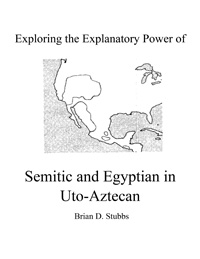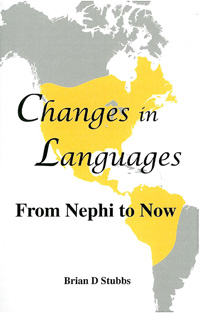Introduction
Explanatory power is the ability of a hypothesis to explain what is otherwise not explainable. Explanatory power is what linguists look for to identify the best among competing theories to explain what happens in language. For a century, the answers to many unresolved questions in Uto-Aztecan linguistics eluded Uto-Aztecan (UA) specialists. While the language ties in this title may seem unseemly to some, they provide more explanatory power to the unknowns of UA than many might be comfortable with initially. So take your time. This study is exploratory, a work in progress toward answers, not yet having them all. Nevertheless, if the ties are valid, then ignoring them is like finding written records of Proto-Indo-European (PIE) and then ignoring those PIE records in comparative Indo-European studies. A valid key can provide instant progress to what would otherwise take decades or be impossible.
Uto-Aztecan is a Native American language family of some 30 related languages, mostly in the western United States and Mexico, from the Utes in the north to the Aztecs in the south, with Hopi, Pima, and others between (map on page 41). Some 1500 correlations between UA and three Near-Eastern languages, consistent with the linguistic comparative method (pages 9, 16), create a case at least as viable as the first accepted treatise establishing each Native American language family.
Knowing how unwelcome such a proposal would be in the linguistic community and being a peace-loving recluse by nature, I have been in no hurry to invite the avalanche of controversy upon me. However, equally risky is pressing my luck in postponing a presentation that should reside on this side of the mortal divide. So as youth becomes a more distant memory, I end the four-decade delay to share these findings, which, as both a Semiticist and a Uto-Aztecanist, I could not help but notice during three decades of writing the reference book Uto-Aztecan: A Comparative Vocabulary (UACV, Stubbs 2011), favorably received by Uto-Aztecanists, though no two UA specialists will agree on all aspects and reconstructions, as Kenneth Hill notes in a favorable review in the International Journal of American Linguistics (Hill 2012). After any comparative work, adjustments follow, and this work has a few adjustments to that 2011 work. A case not valid unravels with scrutiny, while truth is further substantiated with time, accumulating more and more support. So this work is not the final word, but an introductory offering. Let each consider all the data, then decide for oneself. Anything less is not a fair assessment. The strength of a case for language ties lies in the quantity and quality of the similarities, so to short either disqualifies a partial review as a fair judgement.
While this study is intended for linguists, Semiticists, and Egyptologists–and therefore includes the linguistic rigor demanded by the comparative method–it is also designed to be accessible to the astute and interested lay person by including explanations and (1.1) an introduction to linguistics (language science), which linguists can skip; (1.2) a brief outline of Semitic languages, which Semiticists can skip; (1.3) an even briefer word about Egyptian, which Egyptologists can skip; (1.4) and an introduction to UA, which even UA specialists should not skip. As the number who are specialists in all those areas approaches zero, most would benefit by perusing some of them. Of course, those lightly interested can skip them all, simply look at the pronunciation table, the Near-Eastern forms in bold, the associated UA forms, and get out of it what they may. However, for a better understanding, one is encouraged to read and refer to the introductions not within one's specialties. Sections 2, 3, 4, and 5 focus mainly on consonant correspondences of the 1500+ parallels; section 7.1 addresses vowel correspondences; section 7.3 treats grammatical and morphological parallels.
After Sapir (1913, 1915) established Uto-Aztecan as a viable family of related languages, Voegelin, Voegelin, and Hale (1962) produced the first numbered list of 171 cognate sets (groups of related words, page 13). Klar (1977) brought the Chumash languages to clarity with 168 sets. Taylor (1963) established Caddoan (a language family of the central plains), assembling 107 cognate sets. Hale (1962, 1967) did the definitive study for Kiowa-Tanoan with 99 sets. This work's proposal may better compare to tying two distant language families, as did Haas (1958) by ending four decades of controversy in uniting Algonkian-Ritwan, an eastern U.S. family with a west coast family, by means of 93 sets. Chamberlain (1888) began the union of Catawba with Siouan via 17 comparisons, and Siebert (1945) secured it with mostly morphological correlations, as not enough clear cognate sets were known at the time to establish correspondences (Campbell 1997, 140). Thus, the going rate is between 50 and 200 sets to establish most Native American language families. So this case of 1500 sets merits proportionate consideration.
Some characteristics of UA are different or not at all like Egyptian or Semitic, but reflect influences rather typical of Amerindian language families, which we would expect of a transplant from the outside into the Americas. One example is suppletion in singular vs. plural verb forms. That is, one verb is used for singular subjects and an entirely different word is used when the subject is plural, while suppletion is nearly non-existent in Semitic or Egyptian. A score of such pairs in UA show such influences on UA. Semitic conjugation morphology (patterns of how verbs are conjugated) is not productive in UA, but hundreds of fossilized forms of both the suffixed/perfective conjugation and the prefixed/imperfective conjugation are found in UA. (See Introduction to Semitic 1.3, for Semitic conjugation morphology; see 1.12, for productive vs. fossilized, still producing forms vs. fixed and no longer producing forms.)
In contrast to differences, other grammatical features align and substantial amounts of Uto-Aztecan vocabulary produce consistent sets of sound correspondences (1.11, p. 13) between UA and the Near-Eastern languages, with each treated as a separate entity. For example, among the consistent patterns of sound correspondences, some 40 examples show Hebrew b corresponding to p of Proto-Uto-Aztecan (PUA); i.e., Hebrew / Phoenician b > PUA *p (> means 'became' or 'changed to'; < means 'changed from'; * marks a proto-form or original sound or word as reconstructed by linguists. So Hebrew b > PUA *p means Hebrew b changed to what linguists see as originally *p in UA). The following matches are a few from among many more examples of each sound change, and, of course, are naturally abbreviated from the fuller data and explanations found in the numbered paragraph sets. Non-linguists may want to read at this point the introduction to linguistics (1.1, p. 13) and the introduction to Semitic (1.2, p. 27). Verbs in Semitic consist of three consonants (bṣq, for example) subject to a variety of vowelings for different aspects, conjugations, adjectives, and nouns (C = any consonant, an unknown consonant):



